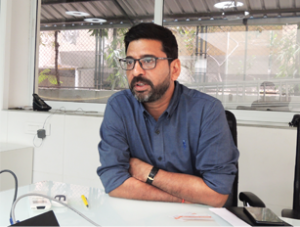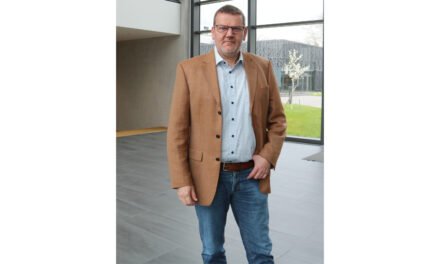
Solunaris GmbH located in Wiesbaden – Germany was founded in 2010 with the aim of satisfying global active customers with high quality products & services in the segment of digital textile printing. Innovative reactive inks under the brand Antelos®. Latest production equipment and quality assurance technologies ensure consistent high product quality. In an exclusive interview with Apparel Views Editorial team, Sandeep Gupta, Head of Business Development (Asia Pacific) – Solunaris GmbH talks about the company, its current scenario and outlook of the digital textile printing market in India.
Please tell us more about your company?
Solunaris was founded in 2010 in Germany. We had received from our customers many requests for a dedicated high quality level service along the entire value chain of digital textile printing. The best way to satisfy this we observed was to establish an independent unit and we selected Germany because we have to remember at that time this industry was still quite new and to a major extend concentrated in Europe. We offer a wide range of “Antelos” reactive digital printing inks for digital textile printing on natural & cellulosic fibres and cover all leading print head technologies.
One of our core strengths is intensive research & development, very stringent quality assurance technologies and our dedication to meet quickly customer requirements. Our company today is the preferred partner for leading digital printing customers who demand high quality products at competitive prices. The groups professional teams support their customers in all application steps & are capable to fetch complete solutions to end-users. The products meet ecological requirements like Oeko-Tex Standard 100 and GOTS. We have two production sites, one in Germany, and one in India to fulfill the requirements of Asia pacific customers.
Why did you decide to enter the Indian market with digital textile inks?
We have conceived right from the beginning that India in particular & Asia pacific in general were to become the key potential markets for the digital printing industry which is growing @ 20 per cent per annum. Importing the products and maintaining efficiently all supply chain parameters became increasingly Alimitation hence we decided to invest in India too for manufacturing digital printing inks and we started our plant in India in 2013. I can assure you this plant was set up not compromising in any way our high Germany technology standards and so we offer without interruption our inks at the acknowledged high quality and with the proper response time.
Solunaris developed successfully under guidance and with financial investment of Jay Chemical Industries. Jay has over 50 years’ experience with continues growth in the textile industry and is nowadays as a diversified group of companies with a turnover of $200 Mn. They have a reputed customer base globally and a major market share in India. The same customers started to invest in digital printing and we as Solunaris are right here with our local professionals in all states. This guarantees our customers successful endeavour also in the still young digital textile printing segment in the best interest of our mutual business.
What is the main USP of your products you are offering?
Solunaris is a fully backward integrated company. We can be proud to say we sell and market self-manufactured products only. Due to this unique status, we are able to control the consistency and quality of our finished products from the raw material stage. Moreover, today we offer the widest range of reactive digital textile printing inks for all established print head technologies and this includes customised ink solutions.
Do you think in future pigment is going to be in trend?
We have seen interesting developments in this segment. The advantage associated with pigment based printing is the one step process of pre-treatment and no chemical post treatment compared to the more demanding reactive printing process. As you know due to the lack of affinity of pigment inks to the fibre, adhesion is obtained by the binder, a co-polymer. The binder is a crucial element and determines many of the characteristics of the product. Because of the harsh feel and lower fastness properties, not to forget the higher pigment ink cost, we think pigment is rather restricted in gaining momentum & limits the application.
What edge does Solunaris has over other companies operating in this segment?
We believe that quality assurance & quality control together with technical expertise and quick response time are the differentiating factors that lead to customer satisfaction and ensure our credibility.
By saying this we do not take our achieved status for granted and we strive constantly to offer added value to our customers.
Most of the ink companies usually have tie-ups with machine manufacturers as certified ink supplier. Do you have any such set-up?
We follow a continues process of improving the quality of our products in close cooperation with our customers, leading machine manufacturers, print head manufacturers and colour management software providers. We value the synergy of close association with all members of the digital printing supply chain as very important and being the key element for successful and sustainable growth in this business.
How do you look at the growth of digital textile printing?
The design process, no limitation of repeat sizes, a wider colour gamut, digital textile printing has enabled more customization and personalization as well as sustainable production, economic short runs, and shorter delivery times at reduced stocks and improved inventory cost. This is leading to strong growth forecasts in the digital textile market not only over the coming years but longer term too. This is allowing the fashion industry to truly take advantage of the benefits of digital printing at production scale with high productivity.
Now, with more high-speed machines coming in, do you think in future digital printing will substitute rotary printing?
As the digital printing technology has developed over time and with the advantage of impressive high speed single pass printers, increasingly older conventional printers are replaced by digital printers. And this investment trend is still good. In addition, we see parallel growth in both conventional & digital printing and many investments are happening in analogue rotary printing machines and in digital printing machines. This growth trend we expect to continue. In fact, our forecast is that demand for digital printing will grow faster than for conventional printing, as the factors like environmental impact, capital investment & running cost are developing more and more in favor of digital printing. Our positive projections are set until the year 2021 but we expect this development to continue also afterwards.
Which will be the major markets for you in the coming years?
We are thankful that since the beginning of our activity, Solunaris has been recognized as quality leader and competent and reliable partner. We have received overwhelming response from our customers. There is significant potential for growth in a number of countries like India, Pakistan, Bangladesh, Indonesia and China and this list can certainly be extended.
How do you see competition from ink manufacturers from China?
Well, it is our daily work to monitor competitor activities. The Chinese quality standard has improved and we must remain active to keep a substantial lead. In fact, we have also a good market presence in China and the demand for our high quality Antelos inks is growing.
As I had described earlier on our customer segment is at the higher and high end of the demand scale and therefore we sell to customers who produce also for the higher quality market, export their textiles to leading fashion brands or are conscious for value addition through our technical service.
Which support do you provide as an ink manufacturer?
To achieve optimised quality of the printed output some customers need substantial technical support in terms of creating right synergies between padding recipes in pre- treatment, deriving right profiles for various substrates & print head technologies, optimizing the post treatment processes and of course using well performing inks like our Antelos inks. Our team with in depth knowledge and many years’ experience of all key components in digital printing supports customers in all these aspects.
Please tell us more about the digital studio you have setup?
We created a printing house in Ahmedabad where we have digital printing machines equipped with different print heads. Here we run multiple tasks such as quality management, training of our team members, training of our domestic and international customers and project execution like applying customer duplicated operation processes in house prior transferring them to the customer sites.























